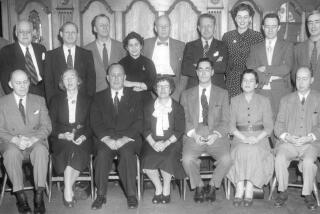MASTERS OF BEDLAM: The Transformation of the Mad-Doctoring Trade.<i> By Andrew Scull, Charlotte MacKenzie and Nicholas Hervey</i> .<i> Princeton University Press: 375 pp., $35</i>
Originally called an “asylum for the criminally insane,” Broadmoor is the best known of Britain’s top-security mental hospitals. Opened in 1863, this vast sprawl of handsome red brick on top of a hill in the countryside west of London houses many of the most notorious British murderers. In 1956, my father, then a young forensic psychiatrist, was appointed the medical superintendent and, for the next quarter century, we lived just outside the walls. Broadmoor was a moribund institution in those days, and my father spent the bulk of his career bringing it out of the Victorian age and into the 20th century. “Masters of Bedlam” is the story of his predecessors, the first of the British superintendents, and of how the asylums they ran evolved from the ghastly fetid dungeons of the late 18th century to the relatively humane places they became a hundred years later.
The large Victorian asylum has had bad press in recent years, but as “Masters of Bedlam” makes abundantly clear, it was an enormous improvement on what had come before it. In the 18th century, the incarcerated mad were treated little better than animals. Chained naked to the wall in crumbling, ill-ventilated buildings, they suffered gross abuse at the hands of their keepers and lived in filth. Interest in their treatment was first aroused toward the end of the century, and reports of the madness of King George III gave that interest added impetus. Medical men began thinking seriously about insanity; a growing affluence permitted families blighted by mental illness to pay others to care for their troubled, and troublesome, members. Thus at the dawn of the consumer society did the “mad-doctoring trade” come into being. “Masters of Bedlam” describes how that “trade” was eventually wrested from private entrepreneurial hands and brought under state control and how the mad-doctors--eccentric mavericks, many of them, in the early days--turned themselves into a respectable self-governing professional body.
There is a distinct danger in this sort of book that the reader will be bogged down in a morass of detail. The birth and growth of the modern asylum and the parallel development of the psychiatric profession necessarily have to do with parliamentary commissions of inquiry, the establishment of bureaucratic bodies, theories of insanity and so on. The authors of “Masters of Bedlam” have attempted to minimize the risk and give their story a human dimension by concentrating on seven of the most prominent men active in “mad-doctoring” in the 19th century. Several of these, the brilliant but cantankerous Henry Maudsley, for example, emerge with great vividness, and along the way some extraordinary events come to light, such as the grisly end of a Lunacy Commissioner called Lutwidge who, while inspecting an asylum, was murdered by a patient who drove a nail into his skull. But the general reader will inevitably find the going heavy for at least some of the time. This is academic rather than popular social history.
The most important early battle of reform was fought over mechanical restraints: fetters, manacles, whips, chains and straitjackets routinely used to control the insane. John Haslam, first of the masters of bedlam described here, advocated what became known as the “moral treatment,” an approach that emphasized an attitude of kindness and gentleness toward the insane, active respect for their essential humanity and the desirability of inducing them to “collaborate peaceably in their own recapture by the forces of reason.” Haslam was later disgraced when conditions in Bethlem Hospital, where he was the apothecary, were found to deviate scandalously from his precepts of the moral treatment, although the publicity generated did nothing but good for the reformers’ cause.
Haslam later recovered his reputation and went on to argue forcefully that treatment of the mad was a matter for those with medical rather than religious training, another important battle that the doctors had to win if they were to secure their monopoly. He also testified frequently in legal proceedings and once, when asked to define the difference between a sound and unsound mind, snapped: “I never saw any human being who was of sound mind. I presume the deity is of sound mind, and he alone.”
The nonrestraint movement found its greatest champion in John Conolly, superintendent of Hanwell Lunatic Asylum, which became a showcase of enlightened Victorian treatment of the insane. Conolly was a man who, early in his career, had criticized the asylum movement, arguing that asylums created the very problem they were meant to solve: They actually drove people mad. But when he was given his own to run, he discovered he was good at it and so changed his mind. Employing the moral treatment in Hanwell, he ushered in the golden age of Victorian psychiatry, a period of intense optimism in which the asylum was seen, in the words of one enthusiast, as “the most blessed manifestation of true civilization the world can present.”
Another influential mad-doctor of the period was William Browne, who was appointed superintendent of an asylum without ever having set foot in one before. Like Conolly, he found he was good at it and did much to advance the psychiatric cause on the three main fronts that had emerged: first, in condemning the old madhouses in all their gothic horror; then in advocating the new asylums that, by means of the moral treatment, promised to be idyllic utopias of order and harmony; and, lastly, in ensuring that these asylums functioned under exclusively medical control. By this point, the architecture of the asylum, the character of its superintendent and the classification and segregation of its patients were all seen as crucial elements in the creation of a “great moral machine.”
Browne’s optimism matched that of the Victorian ruling class, which delighted in seeing the forces of disorder managed in so effective and humane a manner. But by the end of his career, he had grown pessimistic about the durability or depth of the “cures” the asylums effected and saw their function as custodial rather than therapeutic.
Now we move toward the disillusion and even, in Maudsley’s case, the nihilism of the late Victorians. Sir John Charles Bucknill’s career shows us a mad-doctor who was also a country gentleman and moved in the highest society, evidence of the level of social acceptance that at least a part of the emerging profession had achieved. Bucknill experimented with alternatives to the confinement of the insane in asylums and attempted an early form of community care, which came to nothing largely because of the hostility of a nervous public. A hundred years later, my father would battle similar prejudice toward the mentally ill with little more success: Each time one of his patients escaped, the media bayed for his blood and the demonization of the mad.
Finally we meet Maudsley. An outstanding scholar, a proud, stubborn, rebellious man, at 24 he became superintendent of the Manchester Royal Lunatic Asylum and within 10 years was the preeminent British mad-doctor. He took great delight in slaughtering sacred cows and, as a result, was increasingly ostracized by his colleagues, ending his life a virtual recluse with the long white hair and beard of an Old Testament prophet. Maudsley mounted the most effective criticism yet of the asylum system, arguing forcefully that patients recovered as well out of asylums as in them. He also attacked the sedation of patients as a form of “chemical restraint,” a charge that would return to haunt the profession in the 20th century.
What most aroused the antipathy of his colleagues, however, was his intensely pessimistic view as to the nature of insanity. Maudsley, subscribing to new theories of evolution and genetics, viewed the insane as degenerates, inheritors of strains of moral iniquity passed down from generation to generation and as such incurable. He supported asylums only to the extent that they segregated the degenerates from the healthy population. Late Victorian society was at this time becoming increasingly alarmed at the idea that in its urban slums thrived semi-barbarous subcultures dedicated to vice and crime; Robert Louis Stevenson’s “Strange Case of Dr. Jekyll and Mr. Hyde” may be read as an expression of this anxiety about the beast that lurked within.
Maudsley’s ideas were influential with the general public, if not with his colleagues, and with the evaporation of the earlier optimism regarding the efficacy of the moral treatment, the asylum movement lost its vitality and slipped into the stagnation that medical superintendents like my father would encounter later in the century. By the end of Queen Victoria’s reign, more than 100,000 men and women languished in asylums that had become little more than “vast receptacles largely devoted to the confinement of those without hope.”
In recent years, the tide has turned still more decisively against the asylum. A policy of deinstitutionalization in both Britain and the United States has turned tens of thousands of the mentally ill onto the streets, the justification being that they are better off out than in, though without adequate after-care it is difficult to see how this claim can be sustained. In the asylums that have survived--Broadmoor is one--psychiatrists have lost the authority they strove with such energy in the last century to win. When my father retired in 1981, his job was divided into several distinct functions, only one of which--that of medical director--was held by a psychiatrist. He was the last of the medical superintendents. This dense and fascinating book is the story of the earliest representatives of that now-extinct breed.
More to Read
Sign up for Essential California
The most important California stories and recommendations in your inbox every morning.
You may occasionally receive promotional content from the Los Angeles Times.










